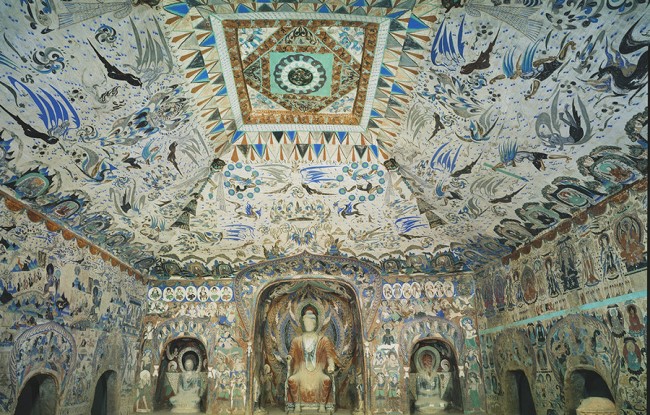Mogao Caves joins VR show trend to enhance experience, improve preservation

The largest and best preserved cave from the Western Wei Dynasty (Mogao Cave 285). [Photo/Chinaculture.org]
Wearing virtual reality headsets and holding controllers, visitors at an immersive digital exhibition in Dunhuang, Gansu province, can explore a digital cave, admire murals up close in high definition and immerse themselves in the stories depicted in the artwork.
The digital re-creation is a life-size replica of Cave 285 of the Mogao Caves, known for housing one of China's most exquisite collections of Buddhist art. Constructed over 1,400 years ago, Cave 285 features a lavish display of Buddha statues and vibrant, imaginative mural paintings. It harmoniously blends various artistic styles inspired by both Chinese and foreign influences in its cave structure and mural content.
To better preserve the cultural relics inside, Cave 285 is rarely accessible to the public as a regular site. However, through the utilization of technologies such as virtual reality, augmented reality and game engines, visitors can enjoy a profound experience that is better than actually entering the real cave.
Using a digital torch, they can illuminate the figurines and discern the intricate details of their attire. They can engage with the thunder god Leishen by playing his drum and even capture videos within the virtual cave.
Lei Zhengguang, a member of the promotion team at the Dunhuang Academy, mentioned that the digital cave serves the dual purpose of preservation and enhancing visitors' experiences.
To visit the caves in person, patrons have to secure tickets well in advance, facing long queues during peak times in the summer and on holidays. To ensure preservation, they are only permitted to visit each cave briefly.
"The digital show is a good way to satisfy tourists' personalized demands and enhance their experiences," Lei said.
The show was co-produced with multimedia giant Tencent, which is based in Shenzhen, Guangdong province. In 2022, a team from the company began creating the show, using game engine technology to give participants the ability to interact with the virtual cave.
"Creating realism and interactivity was the most challenging part," said Wen Feng, who heads the team. "All the things we made virtually are absolutely the same as the real things."
During the nearly six months it took to develop the digital show, Wen spent close to a month at the original cave to get all the details right, including the precise color schemes of the murals.
The roughly 10-minute VR show attracted long lines of people eager to try the technology at a cultural fair in Shenzhen in May, and it has received positive feedback.
The Mogao Caves project is not the company's first in the cultural and tourism industry. It has worked with other famous sites such as the Palace Museum in Beijing, the Great Wall and Beijing's Central Axis to offer immersive digital experiences to tourists, a trend promoted by the country's policymakers.
At the end of May, the Ministry of Culture and Tourism, together with the Office of the Central Cyberspace Affairs Commission, the National Development and Reform Commission, the Ministry of Industry and Information Technology and the National Data Bureau, jointly released the Action Plan for the Innovative Development of Smart Tourism, encouraging the creation of more immersive products and services for tourists by using high technologies.
Many tourist destinations have embraced the trend in recent years.
Apart from the digital show, the Mogao Caves, which receives millions of visitors every year, established a digital Library Cave program last year. It enabled users to virtually experience the rise and fall of the Library Cave, a once-sealed cave that housed countless treasures before its discovery in 1900, without having to travel to the site.
Shu Zhan, head of Tencent's digital cultural lab, said current challenges include ensuring the technology's long-term preservation and the security of its data, as well as maintaining the accuracy and charm of cultural heritage during the digitization process.
"It is necessary to closely cooperate with experts in various fields such as culture, history and architecture to jointly carry out the digital preservation of cultural heritage," Shu said.





 Print
Print Mail
Mail
